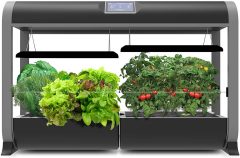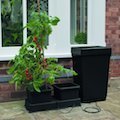Buying guide for best hydroponic garden systems
Many people who want to eat more healthfully are discouraged by the price of fresh produce. And that’s even before product recalls that warn you to throw some items out or risk food poisoning. You could try growing your own vegetables, but the grass along your front walk isn’t exactly sprawling farmland. There is a way to take charge of your health without losing control of your budget, and it’s a hydroponic garden system.
Hydroponic garden systems allow you to grow herbs and vegetables without soil. Instead, the roots rest either in water or a non-soil substrate and absorb nutrients from a solution rather than the soil. Since the plants don’t need soil, a hydroponic garden takes up much less room than a traditional garden. What’s more, many of these systems can be used both indoors and out.
A hydroponic garden system probably won’t replace all your trips to the produce aisle – at least not at first – but it’s a great way to try your hand at gardening if you lack the space to do it the traditional way.
There are hydroponic systems for beginners as well as experienced gardeners, and many can be expanded.
Key considerations
Space
While hydroponic garden systems take up comparatively little room, they still require a dedicated space. You’ll need to decide how much room you want to reserve for growing and choose a system that fits that footprint. Be sure to consider both indoor and outdoor growing spaces, and pick one that will work for you.
Plants
You also need to consider the size of the plants you want to grow. Some systems can only accommodate herbs, while others can fit full-size plants. Plan what you’d like to grow and choose a system that has enough room. When in doubt, choose a system that’s a little bigger than you need (as long as you have enough space). You won’t be disappointed when your plants grow larger than expected!
Light
Some hydroponic gardening kits come with built-in lights; others need to be near a window. Keep this in mind when selecting a space for your garden and the system itself.
Aesthetics
Finally, aesthetics may be a concern, especially if you plan on gardening indoors. Vegetables grow more quickly through hydroponic methods than in soil, but it’s still more than a weekly proposition, so you have to decide what you can accept in your living space. Some pricey hydroponic systems resemble sleek, shapely tubs. Some inexpensive systems have brightly colored buckets that might clash with your décor.
Hydroponic garden system features
Layout
Hydroponic garden systems can take many forms, so you need to see what works best in the space you have. Sleek countertop tubs are best for smaller plants. Large plastic tubs can accommodate larger plants but are best on the floor. Vertical hydroponic systems can save space and look very attractive in a smaller area. Consider your space and desired plants when you shop.
Aeration system
Simply put, without a quality air pump, your plants will drown. The nutrient reservoir that feeds your plants needs circulating oxygen in order to keep the roots from being fully submerged. A quality pump and airstone can keep the roots healthy and the reservoir mixed.
Size: Beginners should make sure the pump gives the reservoir at least 500 to 600 cubic centimeters (cc) or 500 to 600 milliliters (ml) per minute. More advanced gardeners with larger systems should look for pumps where the wattage equals the number of gallons of solution used.
Tubing: You’ll also need tubing to help deliver the oxygen from the pump to the airstone – the part that releases the oxygen into the water. Look for systems with dark, garden-safe tubing. Black tubing is best because lighter colors can lead to algae growth. Look for airstones that create small bubbles, which will release more oxygen into your reservoir than larger bubbles.
Noise: If you’re gardening indoors (or outdoors in a highly populated area), you’ll want to consider the noise volume of your pump system. Some experts recommend looking for a pump rated at 45 decibels or less, similar to the sound level of a refrigerator.
Nutrient mix
Since the plants draw their nutrition from the reservoir rather than soil, a good nutrient solution is key to hydroponic success. Some systems come with a starter nutrient mix that’s good for many plants. With other systems you’ll need to look for your own. You can find some that are premixed and ready to add to your system.
If you plan to add your own dry fertilizers, you should try to keep three on hand: calcium nitrate, Epsom salts (magnesium sulfate), and a nitrogen/phosphorus/potassium (NPK) mix. Buying separate powder fertilizers and mixing them may require a scale that measures ounces and grams, as well as buckets, mixers, and gloves. Because this can get complicated, it’s best for beginners to simply buy premixed fertilizers and look for a system that includes nutrient packs.
Substrate
Many hydroponic systems grow plants exclusively in water. Some plants, like tomatoes and peppers, need a substrate material for their roots to grab onto in order to stay stable and upright. The substrate also holds onto the oxygen that’s vital for root growth. If you’re planning on growing heavier plants, look for systems with sponge, peat moss, clay pebbles, or another substrate. Be sure to check the specifics because different substrates can change the pH or nutrient level of the water.
Did you know?
Vegetables grown in a hydroponic system usually have more nutritional value and higher vitamin content because you’re in control of the mineral mix they receive.
STAFF
BestReviews
Hydroponic garden system prices
Inexpensive
The least-expensive hydroponic garden systems cost between $25 and $50. At this price, you’re usually getting a container, aeration kit, and substrate material. Some, but not all, include seeds and nutrient mixes. These systems are often best for individuals with some gardening or hydroponic experience.
Mid-range
These hydroponic systems cost from $50 to $100 and include a moderately attractive container (which should be larger than that in the lower-priced systems), as well as aeration system, substrate, and nutrients. Some include a pH-testing unit. These systems are designed more intuitively and can work well for experienced gardeners and confident beginners.
Expensive
The highest-priced hydroponic garden systems cost $100 or more. The higher price is usually due to either a larger system that supports more plants or the inclusion of advanced onboard instructions that make the unit foolproof for beginners. These units include all the basics and often come with grow lights, plants, and display screens that tell you exactly how much of any given nutrient to add and when to add it.
Tips
Be careful about substrates. If you decide to use a substrate material, make sure it doesn’t contain too much salt or any other components that could harm plants or people.
Try to keep your indoor growing room between 65°F and 75°F. Most vegetables grow well at these temperatures. If you’re using your hydroponic system to grow tropicals, keep your grow room around 80°F.
- Try growing a variety of plants. Cucumbers, tomatoes, spinach, peppers, herbs, lettuce, and kale can all be grown hydroponically. Plants like squash, pumpkins, corn, and melons are less successful because they’re challenging to grow in a narrow area.
Other products we considered
Tower gardening is popular among hydroponic growers, and many like the Mr. Stacky 5-Tier Vertical Garden Tower. It has a space-saving design and center hole for a hydroponic water line that makes it a favorite. Some say it’s not the most stable product on the market, though. We also like the AeroGarden Harvest system, which is slightly more budget-minded than other products from the same company. It’s smaller in size and in price than some high-end models, but it still gives new gardeners everything they need, including plenty of guidance.
FAQ
Q. My indoor plants aren’t getting enough sun. Do I need to move the whole system?
A. It’s hard to predict how much light your plants will get indoors. If they’re growing tall, spindly stems or the leaves seem small and pale, chances are good that the plants need more light. Instead of taking apart the whole system, consider buying a grow light. These bulbs are designed to mimic natural sunlight and can give your plants a boost if you find the location is too dim. Some hydroponic systems come with a built-in grow light, but one is easy to buy separately if you discover you need one after the fact.
Q. How often do I need to clean out the reservoir?
A. Ideally, you should empty the reservoir and add new nutrient solution at least once a week. Over the course of the week, plants will consume the nutrients, and whatever is left over will build up, change the pH, and potentially become toxic to the plants.
Q. When – and why – should I test the pH level of my nutrient mix?
A. Most hydroponic gardeners shoot for a pH level of 5.5 to 6.5 for optimal results. As the solution gets closer to or above 7.0, the plants stop absorbing nutrients efficiently. If you notice yellowing along the leaf veins or curling leaves, the chances are good that the pH is too high. It’s normal for levels to fluctuate as the plants absorb nutrients from the water, but checking the levels after you add nutrients is the best way to head off pH-related trouble.

























